The Body Keeps the Score by Bessel van der Kolk is a groundbreaking book that explores the effects of trauma on the human body and mind. In this blog post, we will delve into the key concepts of the book, discuss the importance of understanding trauma, and highlight the pathways to recovery outlined by the author.
Understanding Trauma:
Trauma is not a new concept, but van der Kolk’s book provides a comprehensive explanation of how trauma affects our bodies and brains. The author emphasizes that trauma is not just an event that happened in the past; it is something that continues to affect individuals long after the initial experience. Our bodies “keep the score” of trauma, manifesting in various physical, emotional, and psychological symptoms.
“Traumatized people chronically feel unsafe inside their bodies: The past is alive in the form of gnawing interior discomfort. Their bodies are constantly bombarded by visceral warning signs, and, in an attempt to control these processes, they often become expert at ignoring their gut feelings and in numbing awareness of what is played out inside. They learn to hide from their selves.”
The Rediscovery of Trauma:
In the first part of the book, van der Kolk delves into the rediscovery of trauma and the historical practices surrounding its treatment. He explores the evolution of trauma research and emphasizes the importance of understanding its impact on the brain. This section provides a fascinating insight into the development of trauma treatment and the challenges faced by clinicians in the field.
The Minds of the Child:
One of the key aspects of trauma that van der Kolk highlights is its prevalence in childhood and the lifelong effects it can have. The book shines a light on the importance of early intervention and support for children who have experienced trauma. By understanding the imprint of trauma on young minds, we can work towards creating a more nurturing and resilient environment for future generations.
Paths to Recovery:
While trauma can have long-lasting effects, van der Kolk offers hope through his exploration of various paths to recovery. The author emphasizes the importance of a holistic approach that addresses the mind, body, and spirit. Traditional therapy plays a significant role in addressing the thinking part of the brain, but van der Kolk also highlights the significance of bottom-up approaches such as nervous system regulation and mindfulness.
Journaling and Self-Reflection:
The book touches on the therapeutic benefits of journaling and self-reflection. Van der Kolk references a study that highlights how writing can help individuals better understand and define their emotions and experiences. This finding resonates with the power of therapy in helping individuals process and make sense of their trauma. Journaling can be a valuable tool for self-expression and emotional healing.
Creating Supportive Networks:
Another essential factor in trauma recovery is the creation of supportive networks. Van der Kolk emphasizes the importance of social connection and having a good support network. Surrounding oneself with understanding and caring individuals can significantly aid in the healing process. As parents, it is crucial to provide a nurturing environment for children to develop self-confidence and resilience.
Conclusion:
‘The Body Keeps the Score’ takes readers on a profound journey into the world of trauma, offering insights, and strategies for healing and recovery. Van der Kolk’s extensive research and clinical experience make this book a valuable resource for anyone interested in understanding trauma and its lasting effects. By addressing trauma on multiple levels – physical, emotional, and psychological – individuals can embark on a path towards healing and reclaiming their lives.
We hope this blog post has provided a glimpse into the powerful insights of The Body Keeps the Score. If you or someone you know has been impacted by trauma, we highly recommend reading this book. It offers a fresh perspective on trauma treatment and provides hope for individuals seeking a path towards healing and recovery.
